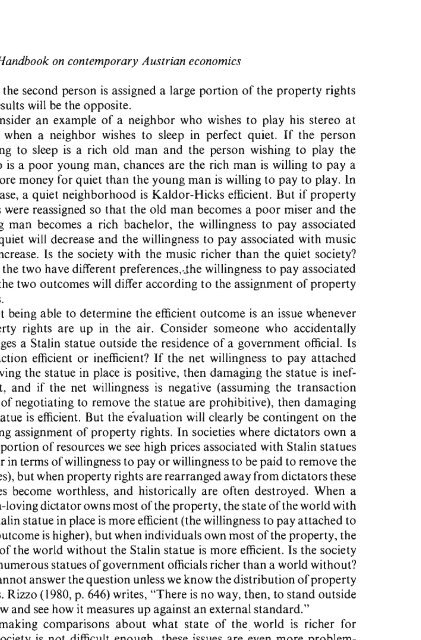Handbook on Contemporary Austrian Economics
Handbook on Contemporary Austrian Economics
Handbook on Contemporary Austrian Economics
You also want an ePaper? Increase the reach of your titles
YUMPU automatically turns print PDFs into web optimized ePapers that Google loves.
60 <str<strong>on</strong>g>Handbook</str<strong>on</strong>g> <strong>on</strong> c<strong>on</strong>temporary <strong>Austrian</strong> ec<strong>on</strong>omics<br />
when the sec<strong>on</strong>d pers<strong>on</strong> is assigned a large porti<strong>on</strong> of the property rights<br />
the results will be the opposite.<br />
C<strong>on</strong>sider an example of a neighbor who wishes to play his stereo at<br />
night when a neighbor wishes to sleep in perfect quiet. If the pers<strong>on</strong><br />
wishing to sleep is a rich old man and the pers<strong>on</strong> wishing to play the<br />
stereo is a poor young man, chances are the rich man is willing to pay a<br />
lot more m<strong>on</strong>ey for quiet than the young man is willing to pay to play. In<br />
this case, a quiet neighborhood is Kaldor-Hicks efficient. But if property<br />
rights were reassigned so that the old man becomes a poor miser and the<br />
young man becomes a rich bachelor, the willingness to pay associated<br />
with quiet will decrease and the willingness to pay associated with music<br />
will increase. Is the society with the music richer than the quiet society<br />
Since the two have different preferences,..,the willingness to pay associated<br />
with the two outcomes will differ according to the assignment of property<br />
rights.<br />
Not being able to determine the efficient outcome is an issue whenever<br />
property rights are up in the air. C<strong>on</strong>sider some<strong>on</strong>e who accidentally<br />
damages a Stalin statue outside the residence of a government official. Is<br />
this acti<strong>on</strong> efficient or inefficient If the net willingness to pay attached<br />
to having the statue in place is positive, then damaging the statue is inefficient,<br />
and if the net willingness is negative (assuming the transacti<strong>on</strong><br />
costs of negotiating to remove the statue are prohibitive), then damaging<br />
the statue is efficient. But the evaluati<strong>on</strong> will clearly be c<strong>on</strong>tingent <strong>on</strong> the<br />
existing assignment of property rights. In societies where dictators own a<br />
large porti<strong>on</strong> of resources we see high prices associated with Stalin statues<br />
(either in terms of willingness to payor willingness to be paid to remove the<br />
statues), but when property rights are rearranged away from dictators these<br />
statues become worthless, and historically are often destroyed. When a<br />
Stalin-loving dictator owns most of the property, the state of the world with<br />
the Stalin statue in place is more efficient (the willingness to pay attached to<br />
that outcome is higher), but when individuals own most of the property, the<br />
state of the world without the Stalin statue is more efficient. Is the society<br />
with numerous statues of government officials richer than a world without<br />
We cannot answer the questi<strong>on</strong> unless we know the distributi<strong>on</strong> of property<br />
rights. Rizzo (1980, p. 646) writes, "There is no way, then, to stand outside<br />
the law and see how it measures up against an external standard."<br />
If making comparis<strong>on</strong>s about what state of the. world is richer for<br />
<strong>on</strong>e society is not difficult enough, these issues are even more problematic<br />
when making income comparis<strong>on</strong>s between different societies. One<br />
must c<strong>on</strong>sider not just how <strong>on</strong>e society would rank two social outcomes,<br />
but how two societies with different sets of preferences would compare<br />
outcomes. When price vectors, preferences, and populati<strong>on</strong> size in two

















